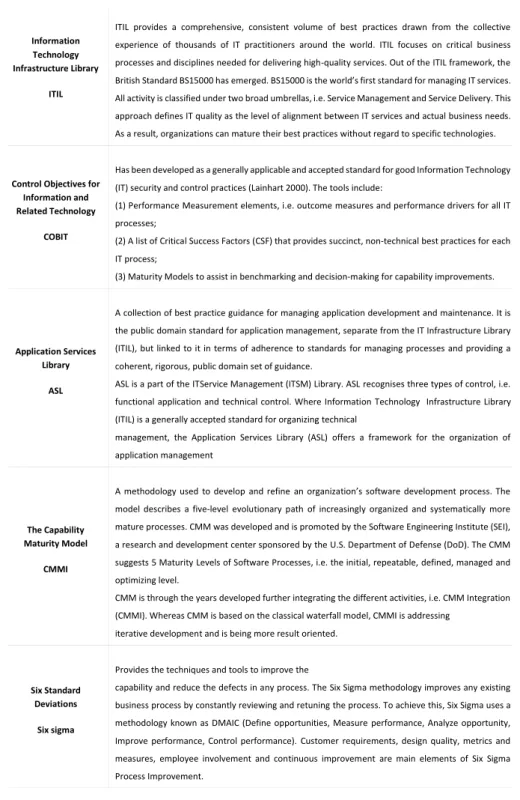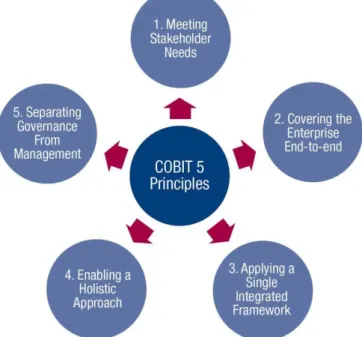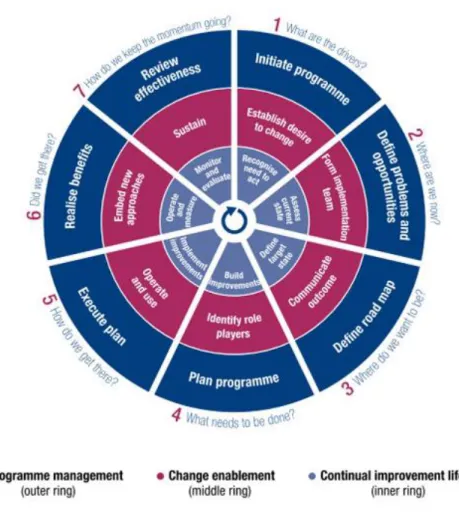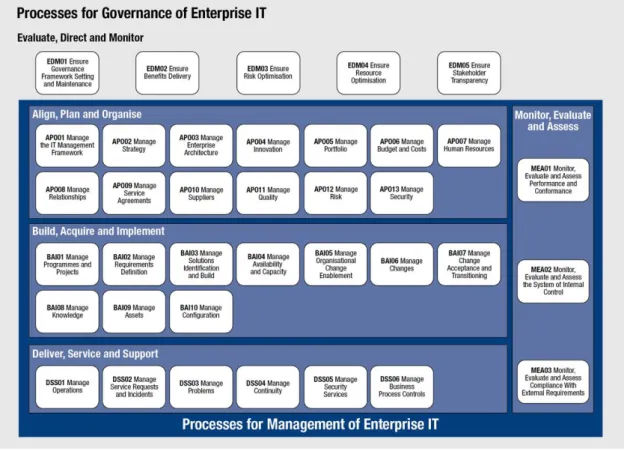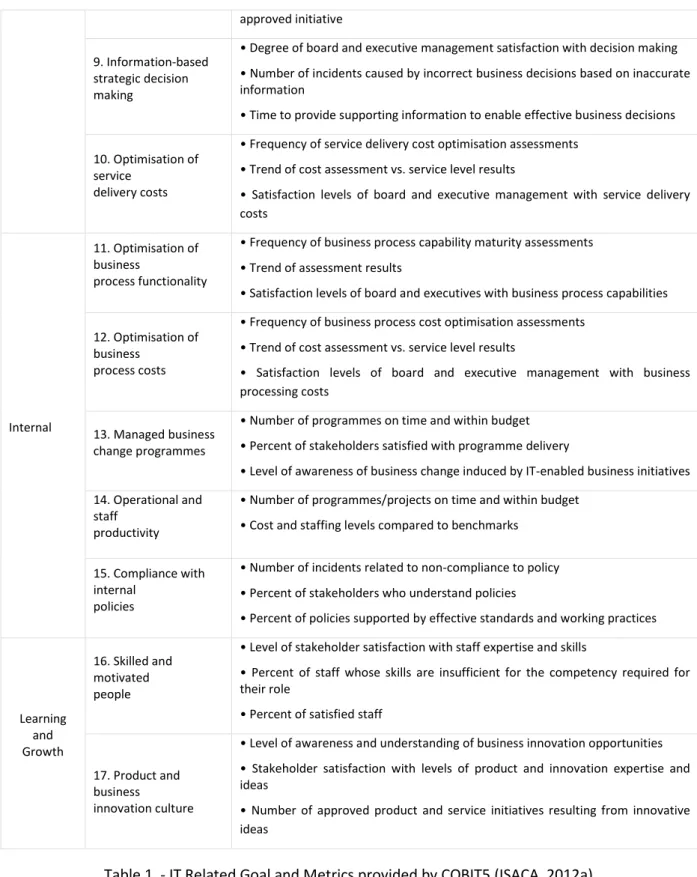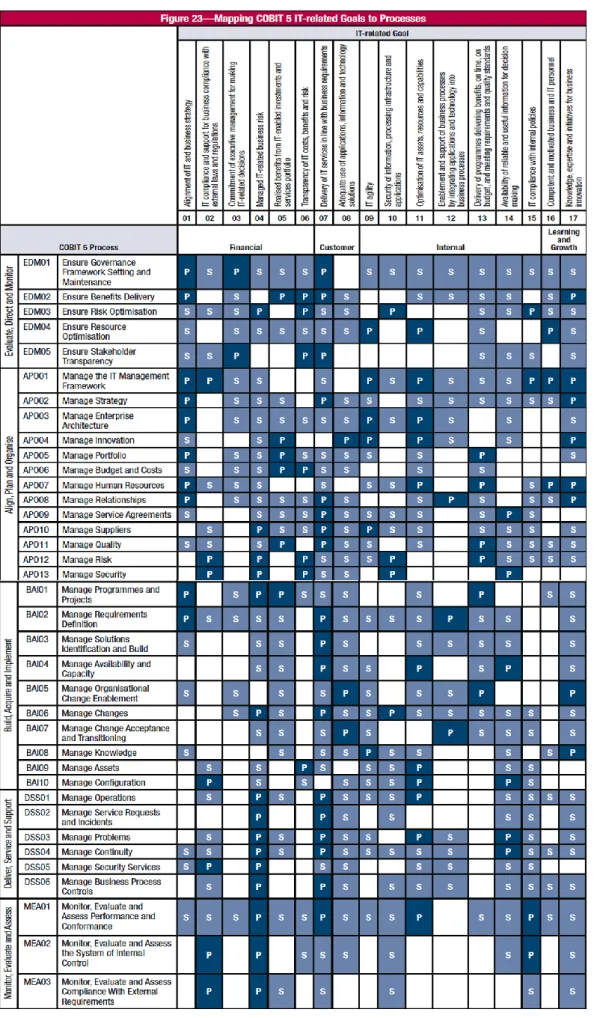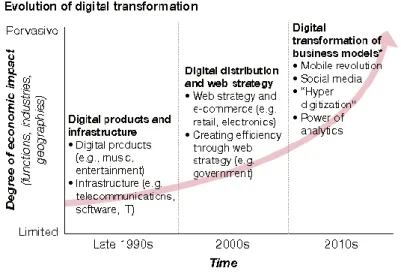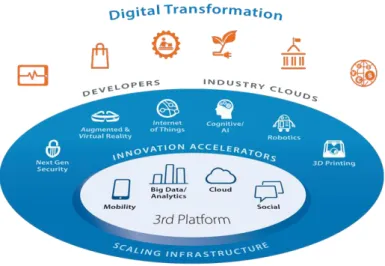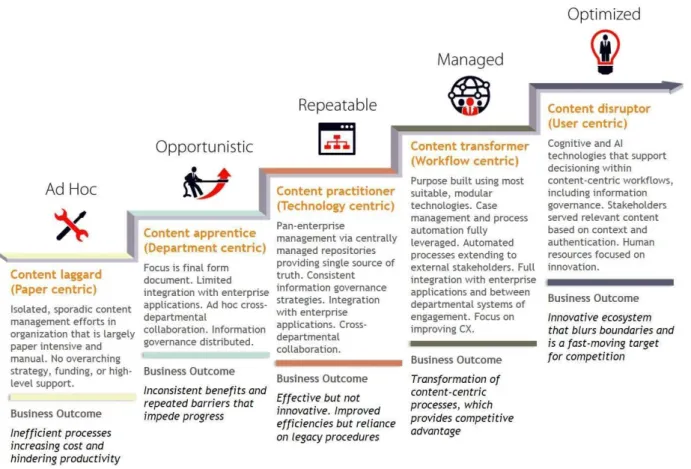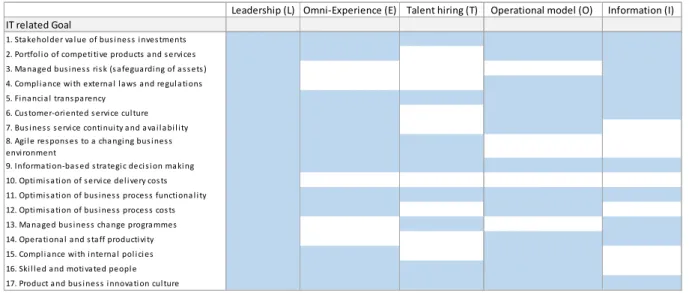IT GOVERNANCE IN DIGITAL TRANSFORMATION
Ana Catarina Saldanha Jerónimo
A COBIT 5 overview according IDC Maturityscape
Dissertation as requirement for obtaining the Master’s
degree in Information Management
NOVA Information Management School
Instituto Superior de Estatística e Gestão de Informação
Universidade Nova de Lisboa
IT GOVERNANCE IN DIGITAL TRANSFORMATION
A COBIT 5 overview according IDC Maturityscape
by
Ana Catarina Saldanha Jerónimo
Dissertation as a requirement for obtaining the Master’s degree in Information
Management, with specialization in Information Systems and Technologies Management.
Advisor:
Professor Vitor Duarte dos Santos
ACKNOWLEDGEMENTS
I would like to thank to my thesis advisor Professor Vitor Duarte dos Santos of the Nova
Information Management School at Universidade Nova de Lisboa, for the continuous
orientation and the construction criticism that allowed the study evolution.
I would also like to thank to Bruno Horta Soares of IDC for the advices and comments given
to this study, which were really important to improve the work and understand the vision of
someone expert in those frameworks.
ABSTRACT
We live in an era where digital transformation is highly increasing, gaining a new importance
to the company’s business. This digital transformation introduces an all new paradigm where
companies have to adapt to be more competitive, more costumer related, allowing them to
present new solutions and new business models.
When implementing this kind of changes, companies must pay attention to the IT
Governance to help them align the IT strategy with the company and the stakeholder’s
strategy and goals.
The motivation and objective of this thesis is to understand how COBIT5 can help to achieve
a higher digital transformation maturity .
This study presents a matrix of the different dimensions of the IDC digital transformation
maturity matrix and relate them with the COBIT5 procedures, helping the organizations
achieve a better maturity in a certain dimension.
This matrix can be used as a guide for organizations dealing with digital transformation, that
after understanding their maturity level on a specific dimension, search assistance to
understand what changes to implement to achieve a higher maturity level.
KEYWORDS
Company strategy, New IT, Governance frameworks, best practices, maturity matix,
procedures.
Index
1.1.
Background ... 1
1.2.
Motivation, objectives and study relevance ... 2
2.
Literature Review ... 4
2.1.
IT Governance ... 4
2.1.1.
Concepts ... 4
2.1.2.
Benefits ... 4
2.1.3.
Frameworks ... 5
2.1.4.
COBIT 5 ... 6
2.2.
Digital Transformation ... 22
2.2.1.
Concepts ... 22
2.2.2.
Main Areas ... 23
2.2.3.
IT Governance in Digital transformation ... 24
2.3.
IDC Maturity Matrix ... 25
2.3.1.
Concept... 25
2.3.2.
Maturity Scape Stages ... 26
2.3.3.
Maturity Scape dimensions ... 26
3.
Methodology ... 30
3.1.
Design Science Research ... 30
3.2.
Investigation Strategy ... 31
4.
Building a Framework ... 32
4.1.
Assumptions ... 32
4.2.
Framework ... 33
4.3.
Discussion and analysis ... 46
5.
ConcLusion ... 50
5.1.
Summary of the developed work ... 50
5.2.
Limitations ... 50
5.3.
Future Work... 51
LIST OF ABBREVIATIONS AND ACRONYMS
DSR Design Science Research
IDC International Data Corporation
IS Information Systems
IT Information technology
ITDG IT demand governance
ITG IT Governance
ITRG IT-Related Goals
FIGURES
Figure 1 - IT Governance Frameworks (Larsen & Andersen, 2006) ... 5
Figure 2 - COBIT 5 - Priciples (ISACA, 2012b) ... 6
Figure 3 - COBIT 5 - Circle of life of the implementation (ISACA, 2012b) ... 8
Figure 4 - COBIT 5 - Processes of Governance of Enterprise IT (ISACA, 2012b)... 9
Figure 5 - COBIT 5 - IT Processes objectives (ISACA, 2012a) ... 12
Figure 6 - Evolution of digital transformation (Tannou & Westerman, 2017) ... 22
Figure 7 - 3rd Platform of Digital Transformation (Magee, 2016) ... 23
TABLES
Table 1 - IT Related Goal and Metrics provided by COBIT5 (ISACA, 2012a) ... 11
Table 2 - COBIT 5 ITRG relation to the IDC matrix dimensions ... 33
Table 3 - COBIT 5 governance practices to suport the digital transformation - Leadership ... 35
Table 4 - COBIT 5 governance practices to suport the digital transformation –
Omni-experience ... 38
Table 5 - COBIT 5 governance practices to suport the digital transformation – Talent Hiring
... 40
Table 6 - COBIT 5 governance practices to suport the digital transformation – Operational
Model ... 42
Table 7 - COBIT 5 governance practices to suport the digital transformation – Information 45
INTRODUCTION
1.1.
B
ACKGROUNDIn the last few years there was a great change in the Information Systems. With the quick evolution of the new technologies it is imperative that organizations adapt in order to be competitive. Subjects like cloud, mobility, artificial intelligence come directly in to our lives. With the unlimited access to the internet and, as a result the access to an enormous amount of information, clients gain a new freedom and knowledge that was not possible before, this makes them the most exigent clients till now (Vey, n.d.). They also have access to new ways of making business (consumer to consumer) and have access to all the organization offers anytime anywhere.
Those changes in society forces the organizations to stay competitive by adapting to the new technologies, not just using them as a performance improvement, but also using them as keys to business, resolving problems, creating value and act like innovation tools, disrupting the system, (Westerman, Calméjane, Bonnet, Ferraris, & McAfee, 2011) which lead to the 4th industrial revolution (Vey, n.d.).
This transformation that is happening is called the digital transformation, where companies use technology as leverage to create value and as a disrupt agent for business.
But to grow in terms of digital transformation it is not just to implement concepts like cloud, internet of things or artificial intelligence, it is not technology for technology, but technology as a part of the company strategy oriented to the business (Hess, Benlian, Matt, & Wiesböck, 2016).
In addition to these trends there are others uprising so IT governance must quickly adapt to all of those changes.
Although it’s very important that organizations enter in this digital transformation, for reasons like costs, time and lack of knowledge this change is not universal.
Each company has its own level of digital transformation and this level can be analysed using a maturity level matrix.
There is a great quantity of matrixes to evaluate a company level (for example CCMI, SPICE, etc) (Proença & Borbinha, 2016) but most of them are process oriented.
Nevertheless, there are new concepts of matrixes that are digital transformation oriented like ICD maturity escape.
According to ICD (Magee, 2016), this matrix evaluates the organizations from a vast number of questions answered according to the actual performance of the company in terms of digital transformation framing the company in one of the 5 matrix levels: AD HOD – Digital resister, Opportunistic – Digital Explorer, Repeatable – Digital Player, Managed – Digital transformer and Optimized – Digital disruptor.
To align this implementation with the company strategy it is vital to use Information Technology governance. Although IT governance has its own characteristics it has to be applied as part of the corporate governance since the final objective is always the company (Zhu & Li, 2014).
According to National Computing Centre, the IT governance has to guarantee: strategic alignment with the company, value delivery, risk management, resource management, performance measurement, return on investment, opportunities and partnership, performance improvement and external compliance, so it is important that organizations have to know how they can improve those aspects (National Computing Centre, 2005).
Back in the days, organizations tend to standardize and homogenise the IT in order to reduce complexity, reduce risks and reduce costs, but today with the current disruption of the business and IT, it is impossible to continue in the same path. Those new trends impact on how governance has to be managed, resulting in new frameworks , standards, processes and strategic planning (Smith, 2013).
1.2.
M
OTIVATION,
OBJECTIVES AND STUDY RELEVANCEThe digital transformation requires a set of great changes to implement in a company, so it is necessary to understand how to implement it as an asset to the company strategy.
It can be taken as an example a context were data analysis, now days, is one of the most important assets. Companies do not just use data for a specific information, but as a way to find patterns that can be used to generate new business models, based on the client’s preferences. This new way of thinking require that governance have new preoccupations that weren’t needed before (Hess, Benlian, Matt, & Wiesböck, 2016).
The aim of this study is to understand the main concerns to have in mind when implementing governance in a digital transformation and how they are treated by frameworks like COBIT5.
The main question to answer is “What are the key dimensions to follow when implementing governance in digital transformation, according to IDC maturityscape, and how are they are managed by COBIT5” which will lead to the main objective of creating a comparison matrix between those two frameworks, that can be used as a support guide for companies to have in mind what processes of COBIT5 can help when achieving a higher level of digital transformation maturity.
This object will be constructed based on the following sub-objectives that respond to specific questions:
How to implement IT governance? Comprehend the concept of governance applied to IT and how it is implemented.
What are the most important dimensions to follow according to the maturity scape? Understand how the matrix is organized and what are the dimensions to follow to achieve the maximum level of the matrix.
Is COBIT5 prepared for the digital transformation according to the maturityscape? Understand the principles of COBIT5 and if they are aligned with the new changes.
What dimensions do the frameworks follow when dealing with digital transformation? How COBIT5 anticipate the needs and what do they suggest when dealing with digital transformation.
Organizations can use this matrix after analysing the maturity level in digital transformation, searching for the best practices that can leverage the company to grow in terms of maturity.
2. LITERATURE REVIEW
2.1.
IT
G
OVERNANCE2.1.1. Concepts
According to Gartner “IT governance (ITG) is defined as the processes that ensure the effective and efficient use of IT in enabling an organization to achieve its goals. IT demand governance (ITDG— what IT should work on) is the process by which organizations ensure the effective evaluation, selection, prioritization, and funding of competing IT investments” (Gartner, 2017).
The IT Governance main areas are (National Computing Centre, 2005): Alignment between IT and Business, IT value delivery, Risk Management, Resource Management.
Governance is extremely important to organizations because: sometimes it is verified a general lack of responsibility and clarity of responsibilities within the projects; there are some major
communication failures between clients and suppliers; there are a lot of gaps between what the
clients require and the IT can deliver; organizations don’t have the perception of what value IT can bring; it is necessary to measure the risks of IT implementations; IT is very complex and it is always changing so it is needed a better management and control (National Computing Centre, 2005). To prevent all of those points IT Governance provides a framework that offers a path to follow.
2.1.2. Benefits
Governance brings many benefits to the organizations when well implemented, providing a greater transparency and accountability for costs, processes and decision making, guaranteeing a Return on Investment (ROI) and value for the Stakeholders (understanding the best practices to apply IT according the strategy and objectives of the company allowing the stakeholders to understand the risks and returns that IT can bring), creating new opportunities and partnership (enabling contacts between companies improving the response to market challenges), creating external compliance like integrating laws, regulations and requisites , Providing a better performance by using the IT not just as a support mas as additional value, leading to better practices and avoiding unnecessary costs (National Computing Centre, 2005).
2.1.3. Frameworks
To help the Governance implementation, there are a set of tools that are available as starting points for it governance model development.
As it can be seen from the following table there are a lot of frameworks that can be used by companies in order to achieve the best practices in Governance(Larsen & Andersen, 2006).
Information Technology Infrastructure Library
ITIL
ITIL provides a comprehensive, consistent volume of best practices drawn from the collective experience of thousands of IT practitioners around the world. ITIL focuses on critical business processes and disciplines needed for delivering high-quality services. Out of the ITIL framework, the British Standard BS15000 has emerged. BS15000 is the world’s first standard for managing IT services. All activity is classified under two broad umbrellas, i.e. Service Management and Service Delivery. This approach defines IT quality as the level of alignment between IT services and actual business needs. As a result, organizations can mature their best practices without regard to specific technologies.
Control Objectives for Information and Related Technology
COBIT
Has been developed as a generally applicable and accepted standard for good Information Technology (IT) security and control practices (Lainhart 2000). The tools include:
(1) Performance Measurement elements, i.e. outcome measures and performance drivers for all IT processes;
(2) A list of Critical Success Factors (CSF) that provides succinct, non-technical best practices for each IT process;
(3) Maturity Models to assist in benchmarking and decision-making for capability improvements.
Application Services Library
ASL
A collection of best practice guidance for managing application development and maintenance. It is the public domain standard for application management, separate from the IT Infrastructure Library (ITIL), but linked to it in terms of adherence to standards for managing processes and providing a coherent, rigorous, public domain set of guidance.
ASL is a part of the ITService Management (ITSM) Library. ASL recognises three types of control, i.e. functional application and technical control. Where Information Technology Infrastructure Library (ITIL) is a generally accepted standard for organizing technical
management, the Application Services Library (ASL) offers a framework for the organization of application management
The Capability Maturity Model
CMMI
A methodology used to develop and refine an organization’s software development process. The model describes a five-level evolutionary path of increasingly organized and systematically more mature processes. CMM was developed and is promoted by the Software Engineering Institute (SEI), a research and development center sponsored by the U.S. Department of Defense (DoD). The CMM suggests 5 Maturity Levels of Software Processes, i.e. the initial, repeatable, defined, managed and optimizing level.
CMM is through the years developed further integrating the different activities, i.e. CMM Integration (CMMI). Whereas CMM is based on the classical waterfall model, CMMI is addressing
iterative development and is being more result oriented.
Six Standard Deviations
Six sigma
Provides the techniques and tools to improve the
capability and reduce the defects in any process. The Six Sigma methodology improves any existing business process by constantly reviewing and retuning the process. To achieve this, Six Sigma uses a methodology known as DMAIC (Define opportunities, Measure performance, Analyze opportunity, Improve performance, Control performance). Customer requirements, design quality, metrics and measures, employee involvement and continuous improvement are main elements of Six Sigma Process Improvement.
…
Each framework provides a guide to follow with the best practices that an organization can follow to implement, manage and monitor IT governance, providing guidelines and measures to effectively utilize IT resources and processes within an organization (Business, On, & Change, 2005).
Most of the frameworks are complementary with strengths in different areas but all of them are based on: the organization Structure, the decision process and communication (Business et al., 2005).
2.1.4. COBIT 5
The business orientation of COBIT consists of linking business goals to IT goals, providing metrics and maturity models to measure their achievement, and identifying the associated responsibilities of business and IT process owners (ISACA, 2012b).
Information is fundamental for all the organizations, and technology have an important part in the company’s business. To use technology as a value to the company it is important improve and maintain high quality information to support business decisions, use IT effectively to achieve business goals, use technology to promote operational excellence, ensure IT risk is managed effectively, ensure organizations realize the value of their investments in IT, achieve compliance with laws, regulations and contractual agreements (ISACA, 2012b).
In order to achieve those values, COBIT 5 is based on five principles:
The first principle, Meeting the stakeholders needs it is focused on bring value to all the organization’s parts, balancing the benefits with risks and resources. These parts have different interests, and priorities, so it is necessary to achieve a middle term to achieve the corporation objectives, the IT objectives and the people objectives (ISACA, 2012b).
The second principle, Covering the enterprise end-to-end means that COBIT 5 tries to integrate the IT governance in the corporation governance and tries to cover all functions and processes and all the people intern and externs that are important for the organization. To achieve this principle, it is necessary to have in mind the governance enablers (resources, models, principles, processes and practices) the governance scope, the roles, the activities and relationships to comprehend the organization as a single organism (ISACA, 2012b).
The third principle, applying a single integrated framework, intend to use COBIT 5 as a unique model of governance and management instead of using different frameworks for different topics. It creates a standard language not technical that can be applied easily by its own or easily integrated with other frameworks (ISACA, 2012b).
The fourth principle, enabling a Holistic approach, divide the organization in seven enablers with different objectives connected between them. Those enablers are: principles, politics and models; processes; organizational structures; culture, etic and behaviours; information; services, infrastructures and applications, people, skills and competences (ISACA, 2012b).
The fifth principle, separating Governance from management, require a separation between the governance and management activities because they attend to different purposes. Nevertheless, it is important that those areas keep interacting (ISACA, 2012b).
To implement the COBIT 5 model it was created a life cycle that should be followed to achieve the changes through their complexity in a more structured way (ISACA, 2012b).
This model is structured in three main components programme management, change enablement, and continual improvement life cycle that are incorporated in seven different phases (ISACA, 2012b). It starts with the recognition and acceptance of the need of an implementation, it identifies the actual weaknesses and creates a desire of change, then it passes by the scope definition, for a target definition making and exhaustive analyses to identify possible flaws and possible solutions giving priorities, then it is the phase of planning practical solutions assuring that the benefits can be identified and measured. On the fifth phase it is time to implement, measure and monitor the changes, so that in the next phase it is possible to understand if the benefits were achieved. On the
last phase the success of the implementation it is analysed, and new requisites are identifying for a need of continual improvement (ISACA, 2012b).
Figure 3 - COBIT 5 - Circle of life of the implementation (ISACA, 2012b)
The process focus of COBIT 5 is illustrated by a process model that subdivides IT into four domains: Align, Plan and Organize, Build, Acquire and Implement, Deliver Service and Support, Monitor Evaluate an Assess (ISACA, 2012b).
For those domains, the COBIT5 has built and reference model that define and describe a list of processes of governance and management usually related to the IT activities (ISACA, 2012b).
Figure 4 - COBIT 5 - Processes of Governance of Enterprise IT (ISACA, 2012b)
To implement this framework in the first place it is necessary to understand the organization context, the etic, the culture, laws and regulations, missions, vision and values, politics and practices, business plan and strategic intentions, operational model, maturity levels, management style, risk capacity, resources and industry practices. Each one of these components will influence on what models and best practices should be used (ISACA, 2012b).
For this particular study these processes will be evaluated to understand if they are engaged in accomplish the maturityscape objectives.
COBIT 5 have an IT-Related Goal (ITRG) approach where it tries to identify the most important objectives to accomplish in order to achieve the enterprise objectives (ISACA, 2012b).
The ITRG are seventeen goals divided in four categories: Financial, Customer, Internal and Learning and Growth. To accomplish the goals there are several metrics to be achieved as it is described in the following table (ISACA, 2012a).
Category IT related Goal Metric
Financial
1. Stakeholder value of business investments
• Percent of investments where value delivered meets stakeholder expectations • Percent of products and services where expected benefits are realised • Percent of investments where claimed benefits are met or exceeded
2. Portfolio of competitive products and services
• Percent of products and services that meet or exceed targets in revenues and/or market share
• Ratio of products and services per life cycle phase
• Percent of products and services that meet or exceed customer satisfaction targets
• Percent of products and services that provide competitive advantage 3. Managed business
risk
(safeguarding of assets)
• Percent of critical business objectives and services covered by risk assessment • Ratio of significant incidents that were not identified in risk assessments vs. total incidents
• Frequency of update of risk profile
4. Compliance with external
laws and regulations
• Cost of regulatory non-compliance, including settlements and fines
• Number of regulatory non-compliance issues causing public comment or negative publicity
• Number of regulatory non-compliance issues relating to contractual agreements with
business partners
5. Financial transparency
• Percent of investment business cases with clearly defined and approved expected costs
and benefits
• Percent of products and services with defined and approved operational costs and expected benefits
• Satisfaction survey of key stakeholders regarding the transparency, understanding and accuracy of
enterprise financial information
• Percent of service cost that can be allocated to users
Costumer
6. Customer-oriented service culture
• Number of customer service disruptions due to IT service-related incidents (reliability)
• Percent of business stakeholders satisfied that customer service delivery meets agreed-on levels
• Number of customer complaints
• Trend of customer satisfaction survey results 7. Business service
continuity and availability
• Number of customer service interruptions causing significant incidents • Business cost of incidents
• Number of business processing hours lost due to unplanned service interruptions
• Percent of complaints as a function of committed service availability targets 8. Agile responses to a
changing business environment
• Level of board satisfaction with enterprise responsiveness to new requirements • Number of critical products and services supported by up-to-date business processes
approved initiative 9. Information-based
strategic decision making
• Degree of board and executive management satisfaction with decision making • Number of incidents caused by incorrect business decisions based on inaccurate information
• Time to provide supporting information to enable effective business decisions 10. Optimisation of
service delivery costs
• Frequency of service delivery cost optimisation assessments • Trend of cost assessment vs. service level results
• Satisfaction levels of board and executive management with service delivery costs
Internal
11. Optimisation of business
process functionality
• Frequency of business process capability maturity assessments • Trend of assessment results
• Satisfaction levels of board and executives with business process capabilities 12. Optimisation of
business process costs
• Frequency of business process cost optimisation assessments • Trend of cost assessment vs. service level results
• Satisfaction levels of board and executive management with business processing costs
13. Managed business change programmes
• Number of programmes on time and within budget • Percent of stakeholders satisfied with programme delivery
• Level of awareness of business change induced by IT-enabled business initiatives 14. Operational and
staff productivity
• Number of programmes/projects on time and within budget • Cost and staffing levels compared to benchmarks
15. Compliance with internal
policies
• Number of incidents related to non-compliance to policy • Percent of stakeholders who understand policies
• Percent of policies supported by effective standards and working practices
Learning and Growth 16. Skilled and motivated people
• Level of stakeholder satisfaction with staff expertise and skills
• Percent of staff whose skills are insufficient for the competency required for their role
• Percent of satisfied staff
17. Product and business
innovation culture
• Level of awareness and understanding of business innovation opportunities • Stakeholder satisfaction with levels of product and innovation expertise and ideas
• Number of approved product and service initiatives resulting from innovative ideas
Table 1 - IT Related Goal and Metrics provided by COBIT5 (ISACA, 2012a)
All of this ITRG can be achieved thru the implementation of several processes, where COBIT 5 has the following mapping:
The COBIT processes are divided in five main areas: Evaluate, direct and monitor (EDM), Align, Plan and organize (APO), Build, Acquire and Implement (BAI), Deliver, Service and Support (DSS) and Monitor, Evaluate and Assess (MEA).
EVALUATE, DIRECT AND MONITOR (EDM) (ISACA, 2012a)
The first group of processes it is directly related with governance and establish actions for the evaluation, direction a monitorization of IT, in order to guarantee its value for the company. It is mainly directed to the leadership and helps to define responsibilities, risk and resource optimization, and ensure the transparency for the stakeholders.
EDM01 - ENSURE GOVERNANCE FRAMEWORK SETTING AND MAINTENANCE
Articulate and analyze the IT governance requirements and implement and maintain effective structures, principles processes and practices with a clear view of the responsibilities and authority to achieve the company’s mission, goals and objectives
Provide an integrated and consistent approach, aligned with the enterprise governance, assuring that the IT decisions are in line with the company strategy and objectives, analyzing them thru effective and transparent methods and guaranteeing compliance with legal and regulatory requirements. Identify and interact recurrently with the stakeholders, understand and document the requirements and analyse the current and the future design of the IT governance.
Provide information to the leaders and work with them with their support and commitment. Guide the practices, processes and structures according the governance alignment principles, decision making models and authority levels. Define what information is important for the decision-making process.
Monitor the IT governance effectiveness and performance, evaluate id the structures, principles and processes are operating effectively.
EDM02 - ENSURE BENEFITS DELIVERY
Optimize the business processes, IT services, and IT assets as a contribution for the business value at acceptable costs.
Create an accurate picture of costs and benefits to understand if the IT value is achieved for the company with a cost-efficiency and evaluate them frequently maximizing the value.
Monitor the main goals and metrics to understand if the business is gaining the expected value and if there are benefits from the IT investments. Identify the problems and consider corrective actions. EDM03 - ENSURE RISK OPTIMIZATION
Understand and identify the risks that the organizations are willing to take and ensure that they are articulated with the IT value. It is important that the risk do not exceed the IT value, always trying to minimise the failures.
Always maintain the examination and the risk judgment in the present and future and keep a continuous evaluation and monitorization of the goals and metrics and if the risks are worth it according to the IT value that will be brought.
EDM04 - ENSURE RESOURCE OPTIMIZATION
Ensure that there are enough resources that can support the objectives in an efficient way and at an optimal cost, always ensuring the resources needs through the full economic lifecycle, monitoring the main goals and metrics for the resource management and understand how the problems can be identified, followed and remediated.
EDM05 - ENSURE STAKEHOLDER TRANSPARENCY.
Ensure that every information related to the IT is transparent and follows the metrics previously defined by the stakeholders.
Ensure an effective and qualified communication and reporting that follows pre-defined principles to promote a better performance aligning the objectives with the company strategy. Those principles must be revised, and the effectiveness of the communication should also be monitored to ensure they are still a value for the strategy alignment.
ALIGN, PLAN AND ORGANISE (APO) (ISACA, 2012a)
This group intend to identify how the IT can contribute to the organization objectives in terms of IT strategy, IT architecture, innovation and portfolio management. It also provides actions to manage the IT development flow focusing on points like budget, costs, human resources, services, suppliers, risks, quality and security.
APO01 - MANAGE THE IT MANAGEMENT FRAMEWORK
It is imperative to clarify and maintain the IT governance vision and mission, and how the IT is coordinated with the organization strategy, for that it is important to implement mechanisms to manage the IT thru principles and policies that cover all the processes, structures, roles and responsibilities to improve the decision making.
It is necessary to identify what the organisations already have and if it is necessary to continuously improve or create new organisational structures, establish roles, responsibilities and Information ownership, attribute authority and responsibilities, define the enablers to promote compliance, improvement, and handle process deviations. Everyone must know their part and understand the IT objectives and directions.
APO02 - MANAGE STRATEGY
Align, identify and define the IT strategy in order to be integrated with the business objectives. To proceed with this alignment, it is necessary to understand the enterprise environment, objectives, strategy and business processes and also to identify the main problems capabilities and performance to understand how it can be improved.
Create a strategic plan and road maps to achieve the companies’ goals and objectives and communicate it to the appropriate stokeholds and users.
APO03 - MANAGE ENTERPRISE ARCHITECTURE
Create a common architecture that integrate processes, business, information, data and applications, in order to create effectiveness, efficiency, agility and quality.
Understand the gaps and the opportunities that can come from a good architecture implementation and create a plan to implement the architectures or to modify the existing ones in order to achieve value. Those implementations should be monitored along the time.
APO04 - MANAGE INNOVATION
Use innovations as a value to the business needs, analyse the trends, the opportunities and how new technologies can be an adjuvant for the company in order to achieve competitive advantage, and improve the efficiency and effective of the IT.
To use innovation as a benefit, the culture of the company must be innovation oriented creating methods for new ideas to grow.
New methodologies, technology, ideas and their implementation, must be studied, and monitored to gain the approval and support of the stakeholders and to guarantee the real value of the innovation. APO05 - MANAGE PORTFOLIO
It is important for the organizations to set a direction for the investments based on the costs, expected Return on Investment, risks and benefits, aligned the strategic objectives, enterprise worth and risks. To manage those investments organizations can create, monitor and manage portfolios in order to evaluate, prioritise and balance the programmes and services.
It is also important to determine the availability of sources and funds to allocate them according to the prioritization of the programmes.
APO06 - MANAGE BUDGET AND COSTS
The organizations must have a method to manage the IT activities costs and budget. The financial costs must be allocated according to the programmes priorities and risks and the stakeholders vision of what are the benefits for the company. This information must be transparent.
The Costs and budget must always be monitored to understand if there are deviations and if other actions are needed to revert the situation.
APO07 - MANAGE HUMAN RESOURCES
Organizations must ensure the management of the human resources aligning the enterprise objectives with the objectives, motivation and learning and growing plans.
The company must have the resources needed to support the goals, their skills must be identified to understand the best allocation and management.
It is also important that exists a culture of sharing the knowledge and continuous learning. The job performance must be timely evaluated to understand not only the gaps, but also the increasing value of the people.
APO08 - MANAGE RELATIONSHIPS
The relation between IT and the business should be a cooperative relation and must be formalised and transparent in order to achieve all the goals and objectives. Improve the company value thru the IT.
It necessary to have a continuously evaluation, a good definition and the approval of the business requirements, identifying also the risks and opportunities. All this information should be passed to all the stakeholders in a clear and understandable way.
APO09 - MANAGE SERVICE AGREEMENTS
When the organizations work with services it is necessary to deal with service levels so that the service goes to meet the needs and goals. Some indicators should be created for areas like identification, specification, design, publishing, agreement, and monitoring. Thru the evaluation of the service levels it is possible to ensure quality, costs and risks control and an optimization of the performance.
APO10 - MANAGE SUPPLIERS
The management of the suppliers is also an important point for the organizations to have in mind, not only in the supplier intervention thru the meeting of the organization needs, but in the supplier evaluation, selection, contract management, monitoring and compliance. This will ensure quality with low risks at a competitive price.
APO11 - MANAGE QUALITY
Define the quality requirements for all the processes and its controls and monitorization to achieve the organization goals thru a quality management system that provides the standards for the requirements, practices and the procedures, development and service delivery.
Perform a continuous quality monitoring, control and create reviews of the customer satisfaction as well as the value of the quality management implementation.
APO12 - MANAGE RISK
Manage the IT risks thru the identification, evaluation, analysis and reporting of the risks, so that the information can act like a help to the decision-making process. Create a risk portfolio with defined profiles to understand the best way to manage them according to the needs, goals and magnitude of the risk.
APO13 - MANAGE SECURITY
Define or improve a IT security management system continuously monitored and reviewed in order to minimize the risks and security incidents that may occur aligned with the organization policies.
BUILD, ACQUIRE AND IMPLEMENT (BAI) (ISACA, 2012a)
The BAI group focus on the management of IT programmes and projects, aligning the IT strategy with the organization strategy. It also helps manage the capacity, manage the organizational and IT change, and manage the assets and knowledge.
BAI01 - MANAGE PROGRAMMES AND PROJECTS
Manage projects and programmes of the investment portfolio aligning the priorities according to the organization objectives trying to minimize risks reducing costs and ensuring value the quality of the implementations.
Validate the programmes conditions (plans, costs, authorization, sponsorship, stakeholders expectations and engagement) and continually review, monitor and control if the evolution is aligned with the objectives and if the projects ate implemented with quality.
Create a Lifecyle for the programmes and for the projects that are created within, with a start and ends in order to follow a development path that should be monitored and controlled all the way. BAI02 - MANAGE REQUIREMENTS DEFINITION
When defining the IT requirements, it is important to guarantee that they are aligned with the strategic requirements understanding and managing the cost benefits and risk for the proposed solutions.
Always define the functional and technical requirements covering the scope and study the all the possible solutions that ca be performed to achieve the objectives. A Stakeholders approval should always be acquired.
BAI03 - MANAGE SOLUTIONS IDENTIFICATION AND BUILD
Create or improve the management of the implementation lifecycle from the design, development, procurement, test in order to support the objectives with quality assured.
This management should be based in documentation created from the detailed analysis of the information and always approved by the stakeholders. With this method the risks and costs are fewer and the probability of rework or misunderstandings decrease.
To help the monitorizations and the quality assurance it is possible to create SLA’s, implement security control and auditable measures.
BAI04 - MANAGE AVAILABILITY AND CAPACITY
To create a sustainable resource capacity, it is necessary to understand the needs for availability and the best way to optimisation of the system performance predicting the capacity requirements. Create or improve the baseline of resources to ensure a capacity to support the business needs and plan the work according to the priorities and the capacity. Monitor, analyse, measure, report and review availability performance and capacity to identify the gaps and deviations, improving when needed.
BAI05 - MANAGE ORGANISATIONAL CHANGE ENABLEMENT
Create an organizational culture oriented to change. Implement a change management that focus on quick changes in the complete lifecycle with the minimum risk. Prepare the stakeholders and the users to embrace the change communicating in the clearest way the path to follow identifying the wins.
BAI06 - MANAGE CHANGES
Create or improve the change management enabling a fast and reliable delivery of change to the business, mitigating the risks.
Identify and evaluate the changes in order to prioritise them and be prepared for emergency changes. Document track and close the changes that occur.
BAI07 - MANAGE CHANGE ACCEPTANCE AND TRANSITIONING
Create conditions to safely implement the IT developments creating an implementation planning that ensure acceptance tests, audit, communication, the preparation of releases, monitor and support the post-implementation understanding the results, outcomes and lessons learned.
BAI08 - MANAGE KNOWLEDGE
Create and improve the knowledge sharing culture to facilitate the knowledge flow supporting the staff, the processes and the facilitation of the decision making.
Identify the sources of information and create methods and standards to gather the knowledge in an easy and accessible way. Enforce the transformation of information into knowledge.
BAI09 - MANAGE ASSETS
Manage the IT assets guaranteeing that they are operating, reliable and available when needed. Identify the existing assets, what assets are needs, understand the critical ones in other to maximize their use. Ensure the maximum value effectiveness and efficiency thru all the lifecycle.
BAI10 - MANAGE CONFIGURATION
Create or improve a configuration model to maintain a logical model of the services, assets and infrastructure. Establish a configuration repository and a baseline.
Review and control the configuration repository to verify completeness and correctness
DELIVER, SERVICE AND SUPPORT (DSS) (ISACA, 2012a)
The DSS group refers the IT services that are necessary to attend the tactical plans and strategies essentially when it comes to manage the operations and problems that may occur guaranteeing the quality of the processes.
DSS01 - MANAGE OPERATIONS
Coordinate, manage and monitor the operational activities, infrastructures and facilities thru standard operating procedures. Deliver IT operational service outcomes as planned.
DSS02 - MANAGE SERVICE REQUESTS AND INCIDENTS
Create or improve a management process for incident resolution and user request response with a resolution plan that implies a record, investigations, classification, diagnose, track, escalation, resolution and definition of priorities achieving high performance and productivity.
DSS03 - MANAGE PROBLEMS
Identify, classify, diagnose and prioritize problems and understand their root causes and in consequence resolve and prevent recurring problems, improving the service levels, reducing costs and increasing the customer satisfaction.
DSS04 - MANAGE CONTINUITY
After an IT implementation is necessary to provide and effective support to respond to incidents and disruptions. For that it is necessary to define the continuity strategy, policies and its scope to ensure an effective recovery of the company.
Create, review or improve continuously a business continuity plan based on the company strategy and ensure the plan is correctly communicated and executed.
DSS05 - MANAGE SECURITY SERVICES
Create, improve and monitor security measures to protect the organization Information minimizing risks and avoiding vulnerabilities and incidents. Define security roles and users aces privilege.
Create measures like malware protection, networks connectivity security, information encryption and protection, user access security and validations not only for the IT but for the infrastructures. DSS06 - MANAGE BUSINESS PROCESS CONTROLS
Define or improve business process controls to ensure the reliability, traceability and integrity and security of the information and that information satisfy the requirements.
MONITOR, EVALUATE AND ASSESS (MEA) (ISACA, 2012a)
The last group it is focus on the monitorization and evaluation of the objectives achievement, of the gaps and inefficiencies and the assurance of the organization compliance.
MEA01 - MONITOR, EVALUATE AND ASSESS PERFORMANCE AND CONFORMANCE
Continuously evaluate and monitor the IT process goals and metrics. Engage the stakeholders to establish and maintain a monitoring approach to define objectives, scope and methods to measure the relation between the solutions and the objectives. Periodically review and report performance. MEA02 - MONITOR, EVALUATE AND ASSESS THE SYSTEM OF INTERNAL CONTROL
Monitor and evaluate the control environment to understand the major gaps and inefficiencies. Create transparent methods and standards to create a cohesive control management in order to achieve the organization objectives.
MEA03 - MONITOR, EVALUATE AND ASSESS COMPLIANCE WITH EXTERNAL REQUIREMENTS Ensure laws, regulations and contractual requirements compliance of the IT processes.
Identify and monitor the requirements for changes in the laws or regulations and adjust the policies, standards and methodologies to optimize the compliance.
2.2. D
IGITALT
RANSFORMATION2.2.1. Concepts
Today, the growth of new technologies is exponential, every development and discovery leads to new and better ideas, creating a world with a constant disruption and innovation (Cockburn & S. Jahdi, 2015).
As it is possible to see in the following figure, the digitalization had its first main leap in the late 90’s with the digitization of music, films and with the beginning of the immense use of computers and cell phones. In 2000 with the massive use of the internet the markets start to shift with new business models like the e-commerce and businesses for consumer to consumer. But since 2010 with the digital transformation, it occurred not just a change in the IT but also in the society because the digital is now part of people’s life.
Figure 6 - Evolution of digital transformation (Tannou & Westerman, 2017)
The client’s expectations have also changed, they want better products, better services appearing and improving faster and faster. Those expectations forces the organizations to be is constant shifting, putting pressure to develop new products and services(Cockburn & S. Jahdi, 2015).
To enter in this digital transformations there are three paths that can be followed (Berman & Bell, 2011): Improve and reorg the clients value proposal with digital contents and more commitment, enhance or reshape the value proposition with digital content , and build new capabilities around the client.
These changes to the consumer can occur at the service level or as a commitment to the client, using new capabilities such as mobility, interactivity and access to information, improving the quality of service, reducing waiting times generating the best possible experience to the consumer.
Costumers expect good and reliable services delivered at a high speed with improved user experience, personalized according to their tastes and at a low cost (Cockburn & S. Jahdi, 2015). Although the user now has a great role in digital transformation, companies must also adapt to their workers, creating a knowledge-sharing environment, streamlining processes, building innovation capacity and creating the best possible experience (Berman & Bell).
Digital transformation is part of a whole set of possibilities created by the development of information technologies, which have changed not only the companies in terms of operations but also the mentality of the society (Berman & Bell).
2.2.2. Main Areas
According to IDC – International Data Corporation the world is experiencing the third platform of digital transformation(Gens, 2013). It started with the first platform with mainframe and terminals services and passed thru the second platform with the use of LAN/ Internet and Client/server (Smith, 2013):
Figure 7 - 3rd Platform of Digital Transformation (Magee, 2016)
Nowadays we are living in what is called the third platform were the four main pillars are the mobility, the big data/analytics, the cloud and the social media.
Mobility is the use of mobile devices that are radically changing standards and the way that organizations deal with customers and employees. People just do not have one device, they have
multiple devices, in different formats which changes the software distribution creating complexity. Organizations have to deal with multiple operating systems and consequently with security risks and concerns like viruses, data loss and theft (IDC, n.d.)
Data is one of most valuable assets that a company can have so the Big data treatment can be a major asset to the companies. With data it is possible to analyse, predict and identify client’s needs and movements of the competition. But to have valuable information it is needed to capture data from different platforms. Big data allows the organizations to analyse a large volume of data with a great variety at a high-speed input without be certain of its content (IDC, n.d.).
Cloud services are growing exponentially, this allows companies to reduce costs in infrastructure and on in the implementations of solutions that already exists. Nevertheless, implementing this solutions leads to a heterogeneous environment, more complex and partially out of control because it depends on another entity. This paradigm creates for example needs like new IT standards, security and information protection (because another entity is responsible for the databases, servers and disks), and also the application of Service Level Agreements to guaranty a good service and support (IDC, n.d.).
Social Media is a growing tool for companies. The information is available for everyone anytime, so besides the marketing of the company, it is also possible know and to understand the costumers, the employees and the competitors. But social media can also be a danger for the organizations and this control is part of the governance responsibility. As well as it might be an employee productivity reducer, it can also be a way to leak information or to launch a phishing attack (IDC, n.d.).
2.2.3. IT Governance in Digital transformation
With the constant growth and changes in the organizations, the IT gain risks that did not existed before. The systems are more complex and uncertain and the implementations have to be fast and continuous (Cockburn & S. Jahdi, 2015).
The concept of digital transformation lead to some new risks (Tannou & Westerman, 2017):
• Brand Exposure in Social Media – Social media is a great tool to promote the company near the costumers, but a simple post on Facebook or Twitter can receive global attention in minutes, sometimes ruining the company’s reputation.
• Confidentiality and Regulatory Breaches – When employees are able to have access to the company thru a laptop, phone or tablet, the information inside those equipments, is not
secure, not just by hacker’s attacks but also for lost material. Employees can also post public information online leading to confidentiality breaches.
• Increased Demand for Cross-Silo Capabilities – New technologies demand to break out of the old silo based operations to integrate all the areas and technologies so that is possibly to analyse (for example) the information as one single piece.
• Integrated Data - Customers demand an integrated experience, and for that, analytics have to have more data integrated and unified. Companies have to deal with information from multiple platforms.
• Employee Collaboration – The necessity to become more global is a challenge for the companies. Employees have to be able to comprehend all the regions and to share and collaborate in an effective way across the globe.
To prevent those risks, and to make the IT a value to the company strategy, IT Governance can be a great ally for the organizations.
2.3. IDC
M
ATURITYM
ATRIX2.3.1. Concept
There are different types of matrix, however for this study, the matrix that is used is the Maturityscape from IDC.
The maturity matrixes exist as an evaluation form for processes, services or companies to understand in what level they are depending on what it is studied.
The IDC Maturityscape pretend to evaluate the level where the companies are in terms of digital transformation maturity. This matrix is applied essentially to the 3rd platform which includes topics like social media, cloud mobility and Big Data and analytics, because those are the most used technologies to create a company and business disruption (Coimbra, 2016).
This matrix does not intend to give an answer to any CIO question or show the direct way to implement digital transformation, but to identify the gaps that could exist and where the company is comparing to its competitors (Coimbra, 2016).
2.3.2. Maturity Scape Stages
For each company there are 5 dimensions that are evaluated (Coimbra, 2016): Intent: strategy, sponsorship and justification, Data- relevance, quality and availability, Technology - adoption, performance, and functionality, People - skills, culture and organizational structure, Process - tracking, analysis a decisioning
The evaluation of the company begins with an enquiry where are evaluated themes like leadership, omni-experience, talent hiring, operational model and information.
After this evaluation, the company will be assigned with one of 5 levels.
Figure 8 - IDC MaturityScape stages (Holly Muscolino, 2017)
2.3.3. Maturity Scape dimensions
In order to understand the level of digital transformation The IDC maturityscape study the following dimensions (Coimbra, 2016):
a) Leadership
The main goal of this dimension is to help companies develop a vision for the digital transformation, evaluate the leadership capacity, stimulate the dialog between the business and the technology about the objectives, challenges and necessary actions to an effective leadership, identify areas and approaches that need to be perfected, and define rules and approaches to develop the leadership skills.
1. Consciousness and Ecosystem understanding - create a bidirectional flux of continuous information between the digital and the business ecosystem. The management should use this information to create innovation.
2. Innovation on the business model - Create a disruptive leadership that can use new technologies and new business models to influence the market.
3. Disruption in the organizations and in the organization company - The leadership and corporate vision are integrated in the organization. The organizational culture can automatically adapt to changes in the ecosystem.
4. Agility in planning and governance - Give strategic importance to digital initiatives, applying agile methodologies to optimize the performance of the talent, technology, business models and the ecosystem.
5. Economic and financial Leverage - The financing of digital initiatives includes strategic acquisition in the business ecosystem and consider their disruptive potential.
b) Omni-Experience
Omni-experience is defined by IDC as the capacity to attract and increase the loyalty of clients, partners and collaborators thru the creation of interactive experiences. Therefor this dimension describes an omnipresent and multidimensional approach to the ecosystem of the organizations to amplify the product and services experience.
Thru this dimension it is possible to instigate the dialog between the business and technology about the objectives and necessary actions to create an omni-experience thru all the ecosystem, identify the digital transformations areas that need to be upgraded and establish norms to proceed with the initiatives and efforts to implement the omni-experience transformation.
1. Ecosystem experience - To create consistent and innovative experiences to all the ecosystem (clients, partners, suppliers and collaborators).
2. Continuous innovation - to implement a continuous innovation that responds quickly and effectively to the intern and extern necessities.
3. Service platform - Use technologies and services in a disruptive way to improve the experience of all the elements of the business ecosystem.
4. Integrated Marketing - to create a multidimensional and multidirectional marketing in an innovative way using digital connection, influence capacity and experience creation.
a) Talent hiring
This dimension covers the evolution of how the company can achieve its business objectives thru hiring, implementation and integration on intern (employees) and extern resources (contracts, partners, freelancers). It can help companies to evaluate the talent management, the talent hiring, the work optimization, the creation of a digital mentality.
1. Talent management - manage the talent as a competitive advantage. Imply that the talent management systems and the human resources are completely integrated.
2. Talent Acquisition - Acquire the best talent, regardless the organization bond. The implementation of strong networking systems that contribute to identify the talent. 3. Work optimization - Integrate deeply in the business processes the email and messaging.
Unified conference technologies and social networks support the specialist net in the organization.
4. Digital transformation Mentality - Create quickly and frequent changes. The teams must reorganize to achieve the organizational success.
b) Operational model
This dimension describes the capacity to execute operations in a more agile and effective way, helping not only the product and services development, but also the people and digital partners.
The operational model defines how the work is executed in terms of digital transformation. Through this dimension, organizations can enable the dialog between business and technology about the objectives and initiatives, identify where the operational model should be reinforced, and establish norms for the digital transformation initiatives.
1. Product and services connectivity - To implement services and product in digital platforms that generate additional incoming.
2. Active connectivity - To connect the actives with intelligence allowing them to adapt quickly to the operational circumstances.
3. Process coactivity - To normalize the processes with flexible and adaptable support systems. 4. Decision making - Create an integrated decision-making process supported by cognitive and
analytic models.
5. Organization structure - To create an independent area focused on the investment and implementation of digital transformation
c) Information
The information is an approach focused on the extraction and creation of value of information about clients, markets, transactions, services, products and goods. The information should be valuable. This dimension can evaluate the maturity of the information, identify and compered the challenges and opportunities related with information value, identify areas that need to be improved, develop a roadmap to information in the digital transformation.
1. Data discovery: Collection and data process - To have a real-time data discovery of information of all the resources including data, tools and competences.
2. Value development: transformation of data into value - the information must be a differentiating factor being able to suggest decision options using prescriptive analytics. 3. Value realization: monetization of data and information - Understand and measure the value
of the information
4. Collaboration and knowledge sharing - Implement the collaboration a knowledge sharing in real-time
5. Information architecture - The information architecture sustains the digital transformation supporting a vast set of dynamic functionalities of volume, velocity and variety.
3. METHODOLOGY
3.1.
D
ESIGNS
CIENCER
ESEARCHAs a result of this investigation, an artefact will be created, so the adequate methodology for this is the DSR or Design Science Research.
This methodology is frequently used in the study of themes related to Information Systems like decision making support, modulation tools, governance strategies, evaluation methods in IS, and it allows a structured form of achieving the study’s results (March & Storey, 2008).
This specific method has a sequential structure that should be followed to understand the study object. In the first place, the problem is defined and then starts a phase of search that will provide the information to make the analysis which will create a line of thinking that would lead to the final results (March & Storey, 2008).
To create a study based on DSR it is essential to have defined the following structure (Gregor & Hevner, 2013):
• Introduction – with the problem definition, motivation, objectives, and used methods: In this study it will be identified the state of art of governance, and digital transformation and how they are connected, what are the main objectives and the research question, why it is important to create the final artefact and how can it help companies dealing with digital transformation.
• Literature review – search for information that will help to construct a line of thinking: The base for the study will be achieved by reading papers, articles, books and other documents to construct the theory behind the creation of the artefact.
• Methodology used – the DSR methodology: This methodology will be used to construct an artefact based on the literature review that will be revised.
• Artefact description – description of what is the study about: The artefact created will be a framework of evaluation of COBIT 5 in terms of digital transformation according to the IDC maturity matrix.
• Discussion and analysis – Explain the artefact utility and interpret the results: Understand if the framework is a valid artefact and if it responds to the main objectives
• Conclusion – the most important conclusions achieved by the study: After the study is complete it is necessary to create the conclusions where it will be summed up all the process, the importance of the study and how can it be improved.
In summary this study will have in consideration (March & Storey, 2008):
• The problem - Understanding the problematic of governance implementation when it comes to digital transformation; The IT artefact (Solution) – The analyses of the IDC maturity matrix dimensions and how they are applied in the COBIT 5 in terms of digital transformation ; The Discussion and analysis – The analysis of the matrix and the explanation of its usability
3.2.
I
NVESTIGATIONS
TRATEGYIn order to develop this study, the following steps will be followed:
Definition
Understand the problematic IT governance implementation when dealing with Digital transformation • Why is it important?
• Are there studies in this matter?
Literature Review
• What is IT Governance, objectives, importance, benefits? • What are frameworks and how are they used?
• What is COBIT5?
• What is Digital transformation and its state of art?
• What it is known about IT governance in Digital transformation? • What is the IDC maturity matrix and what are its dimensions?
Creating the matrix
• Define the main dimensions for IT Governance in Digital transformation • Understand how the dimensions affect the organizations
• Verify if those dimensions are contemplated in COBIT5 • Explain how the dimensions are managed in those frameworks
Discussion and analysis
• Analise the created matrix • Explain how it can be used • Understand the pros and cons
Conclusions
Conclude if it is according to the mains objectives, define the limitations and define what could be done in the future
4. BUILDING A FRAMEWORK
4.1.
A
SSUMPTIONSAfter studying different types of matrixes and governance frameworks, and after deciding that only two different frameworks would be analysed to limit the scope, this study will have as a starting point the IDC maturityscape that will provide the main dimensions to compare with COBIT 5.
When It comes to the IDC maturity matrix is one of the few that is digital transformation related, it is from a great company in the analyses of the IT Business and it is one of the most relevant matrix in terms of implementation.
For this matrix, as it was previously referred it would be analysed the following matrix dimensions:
Leadership: Consciousness and Ecosystem understanding, Innovation on the business model,
Disruption in the organizations and in the organization company, Agility in planning and governance, Economic and financial Leverage;
Omni-Experience: Ecosystem experience, Continuous innovation, Service platform, Integrated
Marketing;
Talent hiring: Talent management, Talent Acquisition, Work optimization, Digital transformation
Mentality;
Operational model: Product and services connectivity, Active connectivity, Process coactivity,
Decision making, Organization structure;
Information: Data discovery: Collection and data process, Value development: transformation of
data into value, Value realization: monetization of data and information, Collaboration and knowledge sharing, Information architecture.
For each one of these dimensions, COBIT 5 will be examined in order to comprehend if the principle is reflected on the framework, how it is expected to be applied and where is that information presented.
The COBIT5 selection was essentially because it is a very well-structured framework that is quite understandable for everyone dealing with the IT management. When reading the framework, it is possible to see that is also directed to digital transformation, so it would be possible to have a match between the IDC maturity matrix and the COBIT5 processes.
